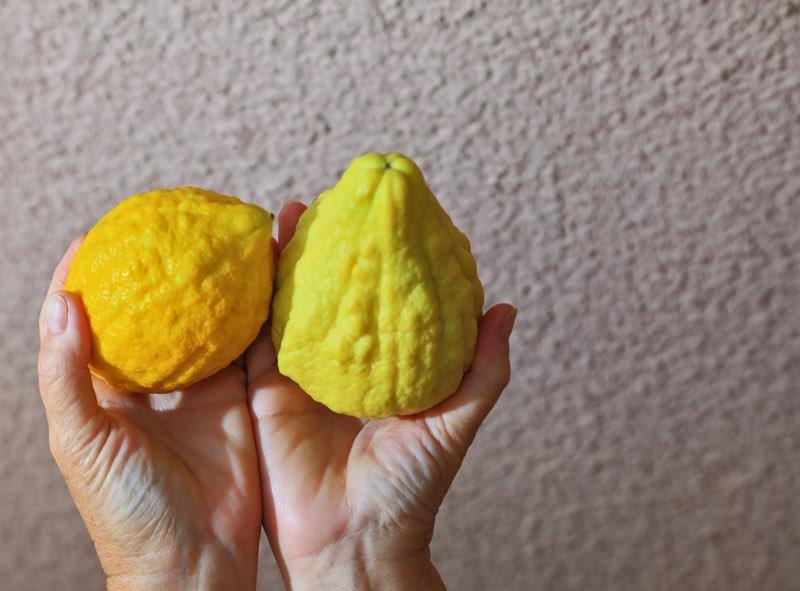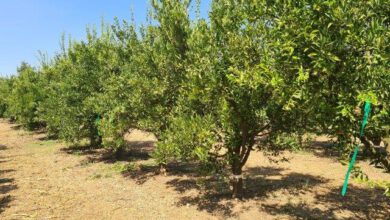Long-term Storage of Etrog Citrons

Maoz Aizikowitz (1) (maoz251@gmail.com), Kailee Shlipak (1,2), Shlomo Cohen (1) and Joshua D. Klein (1)
(1) Institute of Plant Science, Unit for Agriculture according to the Torah, ARO-Volcani Center
(2) University of Southern California, Los Angeles, California, USA
Introduction
Citrons, Citrus medica (or ‘etrogim’, singular ‘etrog’, in Hebrew) are used in the Jewish holiday of Sukkot as one of the four species (‘Arba Minim’) described in Leviticus 23:20 (1)
Every seven years there is a year of rest (‘Shmita’) in Israeli agriculture lands, as described in
Exodus 23:10–11 and Leviticus 25:2–7.(2,3). In this year the land should not be worked, except for essential treatments for the survival of the plants. Commercial harvest of agricultural produce is forbidden, unless there is a ‘heter mechira’, a religious-legal mechanism whereby the land officially does not belong to Jews during Shmita.
An increasing number of consumers do not support use of ‘heter mechira’ and therefore avoid any use of fruits that are produced in Israeli fields and orchards during Shmita, because those have “the sanctity of the seventh year” (‘Kedushat Shevi’it’).
This requires supplying citrons from outside of Israel or developing very long-term storage of Israeli-grown fruit. Long-term storage usually means storing produce at temperatures between 0-10°C. However, storing citrus at such temperatures causes chilling injury symptoms, such as peel browning, tissue breakdown and rots. There are already some effective treatments for extending the storage quality of citrus fruits such as lemons, oranges and mandarins up to 6-8 months, using periods of intermittent warming (20°C for 2-4 days) during extended storage at 10-14°C, or pre-storage dipping of fruit in solutions of the plant hormone gibberellin (GA, Gibberellic Acid). Etrogim are harvested during July, August, and early September.
Unlike other citrus, the market for etrogim is concentrated into a period of less than two months, from the beginning of the month of Elul (usually August/September) before Rosh HaShana to the beginning of Sukkot, seven weeks later (September/October). Given the small market window, extended-storage methods have not been tested on citrons. We studied extended storage of citrons that were harvested at the end of the sixth year, before Shmita, until the beginning of the eighth year, after Shmita (after the 7th year). Our aim was to provide fruit without ‘Kedushat Shvi’it’ to consumers who do not want to use fruit that developed or even were harvested during the year of Shmita.
Unlike most fruit, the quality of citrons is measured only from the outside: peel color, weight, size and shape. Since we received commercially harvested fruit that were acceptable as to size and shape, we only measured peel color and weight during nine months of post-harvest citron storage in temperature regimes that have been shown previously to extend postharvest life of other citrus fruits.
Materials and methods
Citrons of the ‘Hazon Ish’ cultivar were harvested from the Kirshenbaum orchard in Yashresh and were treated with a post-harvest anti-fungal dip (1gr of Berelex (40% gibberellic acid), and 50ml of Vertimek (18gr/lit abamectin) in a 20 liter bath) before transfer to the Volcani Center to be treated with gibberellin from “Merhav Agro” (40gr/liter) diluted to 50ppm or 100ppm or water as a control. The citrons were soaked into their solution for 5 minutes, in a water bath.
After letting the citrons dry, the fruits were packed in plastic bags and kept at 7°C or 12°C in storage rooms. The citrons that were kept at 7°C were moved to 20°C for four days every month (marked ‘T’ in figures 1-3). Fifty-seven citrons were ‘control’ (20 of them with a ‘T’ treatment), 240 were treated with 50ppm gibberellin (40 of them with a ‘T’ treatment), and 160 fruits were treated with 100ppm gibberellin (20 of them with ‘T’ treatment).
Some of the fruits were dipped in 50ppm gibberellin once, twice or three times during the storage period (marked R, RR, RRR, respectively, in figures 1-3), in addition to their original treatment.
The citrons were weighed, and their peel color was measured in H° color units with a Konica-Minolta Chromameter (CR-400).
Results
There were almost no rots detected in the citrons during the storage period. Although the fruits lost about 6% of their weight during the nine months of storage, neither wrinkles nor softening were detected in fruits in any treatment (Figure 1).

Figure 1: Water loss from citrons, calculated from decrease in citrons weight.
(ctrl – control, no treatment.
50 – 50ppm gibberellin treatment. 100 – 100ppm gibberellin treatment.
R/RR/RRR – re-treatment with 50ppm gibberellin once/twice/three times, respectively
T- citrons that were kept at 7°C were moved to 20°C for four days every month)
Up until four months of storage, some of the fruits that were moved between temperatures (7°C to 20°C for four days every month) retained the yellow color of the peel (H°=90 or higher) (Figure 2 and Picture 1).
However, by the ninth month, despite retreatments with gibberellin (R/RR/RRR) and temperature treatments (T), the average color of the peel was in the orange range (H°=78). This is a range of color which is not acceptable by most of the consumers purchasing citrons for religious use, although there is no religious mandate against using such fruit (as opposed to the prohibition against using fruits that are too green (unripe) (Talmud Bavli Sukkah 31b (4)). (Figure 3 and Picture 2)

Figure 2: Citrons Hue angle (H°) after 4 months of storage.
(ctrl – control, no treatment.
50 – 50ppm gibberellin treatment. 100 – 100ppm gibberellin treatment.
R/RR/RRR – re-treatment with 50ppm gibberellin once/twice/three times, respectively
T- citrons that were kept at 7°C were moved to 20°C for four days every month)

Picture 1: Various H° of Citrons peel, picture taken after 6 months of storage

Figure 3: Citrons Hue angle (H°) after 9 months of storage
(ctrl – control, no treatment.
50 – 50ppm gibberellin treatment. 100 – 100ppm gibberellin treatment.
R/RR/RRR – re-treatment with 50ppm gibberellin once/twice/three times, respectively
T- citrons that were kept at 7°C were moved to 20°C for four days every month)

Picture 2: Citrons after 9 months of storage. All in the orange Hue angle (H°) range.
Discussion
During extended storage, citrons harvested with a green peel ripened to a point where the peel became orange. This is unusual in commercial citrons, since they are often harvested before physiological ripeness, which means that they cannot ripen fully in storage. In our experience, the peel of all citrons, like that of most citrus, has the capacity to turn orange, but the rapidity of the change varies by variety. Yemenite citrons often turn orange while still on the tree, while Hazon Ish and Urdang cultivars become yellow, and Calabri citrons can retain their green peel color for extended periods of time even after harvest (Klein, 2014 (5)).
After nine months of storage, citron peels from all treatments were in the orange range of H°. The time period of the experiment was shorter than the Jewish calendar year, but our results mandated early termination of the experiment, since no fruit had retained green or yellow peel color. We found that post-harvest treatment with anti-fungal treatment was very effective, since very few rots were found over the course of the experiment.
In addition, packing the citrons in plastic bags proved effective in preserving fruit turgor, with only 6% weight loss over 9 months.
Although growers often refrigerate compounds to maintain their quality beyond the stated expiration date on the container, the gibberellin that we used evidently did not maintain effectiveness, despite being refrigerated. This could explain why GA treatment resulted in only a relatively short delay in the citron ripening, resulting in fruit developing orange-colored peels.
According to halacha (Shemen HaMor, 648, (6)), orange citrons are kosher and acceptable for the holiday (only dark black or dark green citrons are not kosher) even though consumers prefer yellow over orange citrons. In this case, however, having an orange citron is a sure sign for the customer that those citrons are from the 6th year, if one is desiring a citron which is not from the ‘Shmita’ year. Both Shmita-observant consumers and growers who usually cannot get high prices for etrogim with Kedusha Shvi’it can thus benefit.
This experiment should be repeated with fresh gibberellin and with other citron varieties such as Calabri, Yemenite, Urdang, and Moroccan. In addition, fruit should be stored for at least 11 months to be certain that the fruit will last until the marketing window of the next season.
We thank Shimon Prag and Yisrael Sachs for providing fruit and support for this experiment, and Prof. Eli Fallik for enabling us to store fruit in the Department of Postharvest Science cool-rooms.
References:
1. Leviticus 23:20
2. Exodus 23:10–11
3. Leviticus 25:2–7
4. Talmud Bavli Sukkah 31b
5. Klein, J. D. (2014). Citron cultivation, production and uses in the Mediterranean region. In Medicinal and Aromatic Plants of the Middle-East (pp. 199-214). Springer, Dordrecht.
6. Shemen HaMor, 648




